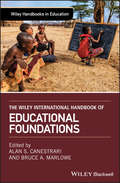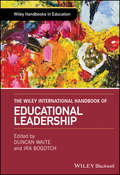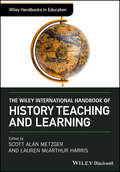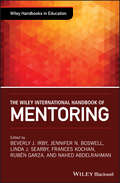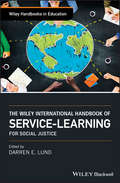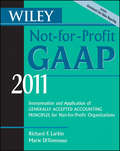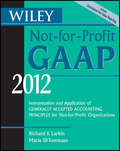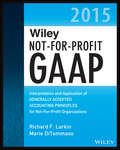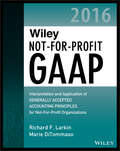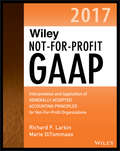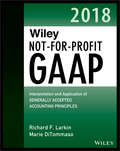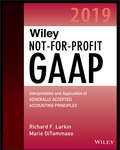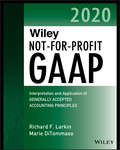- Table View
- List View
The Wiley International Handbook of Educational Foundations (Wiley Handbooks in Education)
by Alan S. Canestrari Bruce A. MarlowePromotes a model of critique for teachers, scholars, and policy makers to challenge established educational practice in a global context. The Wiley International Handbook of Educational Foundations features international scholars uniquely qualified to examine issues specific to their regions of the world. The Handbook provides readers with an alternative to the traditional texts in the foundations of education by taking aim at the status quo, and by offering frameworks from which teachers and scholars of education can critically evaluate schools and schooling. Throughout, the essays are grounded in a broad historical context and the authors use an international lens to examine current controversies in order to provoke the kinds of discussion crucial for developing a critical stance. The Handbook is presented in six parts, each beginning with an Introduction to the subject. The sections featured are: Part I. Challenging Foundational Histories and Narratives of Achievement; Part II. Challenging Notions of Normalcy and Dominion; Part III. Challenging the Profession; Part IV. Challenging the Curriculum; Part V. Challenging the Idea of Schooling; and Part VI. Challenging Injustice, Inequity, and Enmity. The Wiley International Handbook of Educational Foundations offers unique insight into subjects such as: Educational reform in India, Pakistan, and China The global implications of equity-driven education Teacher education and inclusionary practices The Global Educational Reform Movement (G.E.R.M.) Education and the arts Maria Montessori and Loris Malaguzzi Legal education in authoritarian Syria The Wiley International Handbook of Educational Foundations is an important book for current and aspiring educators, scholars, and policy makers.
The Wiley International Handbook of Educational Foundations (Wiley Handbooks in Education)
by Alan S. Canestrari Bruce A. MarlowePromotes a model of critique for teachers, scholars, and policy makers to challenge established educational practice in a global context. The Wiley International Handbook of Educational Foundations features international scholars uniquely qualified to examine issues specific to their regions of the world. The Handbook provides readers with an alternative to the traditional texts in the foundations of education by taking aim at the status quo, and by offering frameworks from which teachers and scholars of education can critically evaluate schools and schooling. Throughout, the essays are grounded in a broad historical context and the authors use an international lens to examine current controversies in order to provoke the kinds of discussion crucial for developing a critical stance. The Handbook is presented in six parts, each beginning with an Introduction to the subject. The sections featured are: Part I. Challenging Foundational Histories and Narratives of Achievement; Part II. Challenging Notions of Normalcy and Dominion; Part III. Challenging the Profession; Part IV. Challenging the Curriculum; Part V. Challenging the Idea of Schooling; and Part VI. Challenging Injustice, Inequity, and Enmity. The Wiley International Handbook of Educational Foundations offers unique insight into subjects such as: Educational reform in India, Pakistan, and China The global implications of equity-driven education Teacher education and inclusionary practices The Global Educational Reform Movement (G.E.R.M.) Education and the arts Maria Montessori and Loris Malaguzzi Legal education in authoritarian Syria The Wiley International Handbook of Educational Foundations is an important book for current and aspiring educators, scholars, and policy makers.
The Wiley International Handbook of Educational Leadership (Wiley Handbooks in Education)
by Duncan Waite Ira BogotchA provocative and authoritative compendium of writings on leadership in education from distinguished scholar-educators worldwide. What is educational leadership? What are some of the trends, questions, and social forces most relevant to the current state of education? What are the possible futures of education, and what can educational leadership contribute to these futures? To address these questions, and more, editors Duncan Waite and Ira Bogotch asked distinguished international thought leaders on education to share their insights, observations, and research findings on the nature of education and educational leadership in the global village. The Wiley International Handbook of Educational Leadership brings together contributions from authors in twenty-one countries, spanning six continents. Topics examined include leadership and aesthetics, creativity, eco‐justice, advocacy, Big Data and technology, neoliberalism, emerging philosophies and theories, critical democracy, gender and radical feminism, political economies, emotions, postcolonialism, and new directions in higher education. A must-read for teachers, researchers, scholars, and policy makers, this Handbook: Champions radical pluralism over consensus and pseudoscientific or political solutions to problems in education Embraces social, economic, and political relevance alongside the traditions of careful and systematic rigor Challenges traditional epistemological, cultural, and methodological concepts of education and educational leadership Explores the field’s historical antecedents and ways in which leadership can transcend the narrow disciplinary and bureaucratic constraints imposed by current research designs and methods Advances radically new possibilities for remaking educational leadership research and educational institutions
The Wiley International Handbook of Educational Leadership (Wiley Handbooks in Education)
by Duncan Waite Ira BogotchA provocative and authoritative compendium of writings on leadership in education from distinguished scholar-educators worldwide. What is educational leadership? What are some of the trends, questions, and social forces most relevant to the current state of education? What are the possible futures of education, and what can educational leadership contribute to these futures? To address these questions, and more, editors Duncan Waite and Ira Bogotch asked distinguished international thought leaders on education to share their insights, observations, and research findings on the nature of education and educational leadership in the global village. The Wiley International Handbook of Educational Leadership brings together contributions from authors in twenty-one countries, spanning six continents. Topics examined include leadership and aesthetics, creativity, eco‐justice, advocacy, Big Data and technology, neoliberalism, emerging philosophies and theories, critical democracy, gender and radical feminism, political economies, emotions, postcolonialism, and new directions in higher education. A must-read for teachers, researchers, scholars, and policy makers, this Handbook: Champions radical pluralism over consensus and pseudoscientific or political solutions to problems in education Embraces social, economic, and political relevance alongside the traditions of careful and systematic rigor Challenges traditional epistemological, cultural, and methodological concepts of education and educational leadership Explores the field’s historical antecedents and ways in which leadership can transcend the narrow disciplinary and bureaucratic constraints imposed by current research designs and methods Advances radically new possibilities for remaking educational leadership research and educational institutions
The Wiley International Handbook of History Teaching and Learning (Wiley Handbooks in Education)
by Scott Alan Metzger Lauren McArthur HarrisA comprehensive review of the research literature on history education with contributions from international experts The Wiley International Handbook of History Teaching and Learning draws on contributions from an international panel of experts. Their writings explore the growth the field has experienced in the past three decades and offer observations on challenges and opportunities for the future. The contributors represent a wide range of pioneering, established, and promising new scholars with diverse perspectives on history education. Comprehensive in scope, the contributions cover major themes and issues in history education including: policy, research, and societal contexts; conceptual constructs of history education; ideologies, identities, and group experiences in history education; practices and learning; historical literacies: texts, media, and social spaces; and consensus and dissent. This vital resource: Contains original writings by more than 40 scholars from seven countries Identifies major themes and issues shaping history education today Highlights history education as a distinct field of scholarly inquiry and academic practice Presents an authoritative survey of where the field has been and offers a view of what the future may hold Written for scholars and students of education as well as history teachers with an interest in the current issues in their field, The Wiley International Handbook of History Teaching and Learning is a comprehensive handbook that explores the increasingly global field of history education as it has evolved to the present day.
The Wiley International Handbook of History Teaching and Learning (Wiley Handbooks in Education)
by Lauren McArthur Harris Scott Alan MetzgerA comprehensive review of the research literature on history education with contributions from international experts The Wiley International Handbook of History Teaching and Learning draws on contributions from an international panel of experts. Their writings explore the growth the field has experienced in the past three decades and offer observations on challenges and opportunities for the future. The contributors represent a wide range of pioneering, established, and promising new scholars with diverse perspectives on history education. Comprehensive in scope, the contributions cover major themes and issues in history education including: policy, research, and societal contexts; conceptual constructs of history education; ideologies, identities, and group experiences in history education; practices and learning; historical literacies: texts, media, and social spaces; and consensus and dissent. This vital resource: Contains original writings by more than 40 scholars from seven countries Identifies major themes and issues shaping history education today Highlights history education as a distinct field of scholarly inquiry and academic practice Presents an authoritative survey of where the field has been and offers a view of what the future may hold Written for scholars and students of education as well as history teachers with an interest in the current issues in their field, The Wiley International Handbook of History Teaching and Learning is a comprehensive handbook that explores the increasingly global field of history education as it has evolved to the present day.
The Wiley International Handbook of Mentoring
by Beverly Irby Jennifer Boswell Linda Searby Frances Kochan Ruben GarzaThe first collection in the area of mentoring that applies theory to real-world practice, research, programs, and recommendations from an international perspective In today’s networked world society, mentoring is a crucial area for study that requires a deep international understanding for effective implementation. Despite the immense benefits of mentoring, current literature on this subject is surprisingly sparse. The Wiley International Handbook of Mentoring fills the need for a comprehensive volume of in-depth information on the different types of mentoring programs, effective mentoring practices, and emerging practical and applicable theories. Based on sound research methodologies, this unique text presents original essays by experts from over ten different countries, demonstrating the ways mentoring can make a difference in the workplace and in the classroom; these experts have an understanding of mentoring worldwide having worked in mentoring in over forty countries. Each of the Handbook’s four sections—mentoring paradigms, practices, programs, and possibilities—include a final synthesis chapter authored by the section editors that captures the essence of the lessons learned, applies a global context, and recommends research avenues for further exploration. This innovative volume demonstrates how mentoring in any culture can help employees to complete tasks and advance in their positions, aid in socialization and assimilation in various settings, provide diverse groups access to resources and information, navigate through personalities, politics, policies, and procedures, and much more. Offers an inclusive, international perspective that supports moving mentoring into a discipline of its own and lays a theoretical foundation for further research Shows how emerging practical theories can be implemented in actual programs and various scenarios Examines a wide range of contemporary paradigms, practices, and programs in the field of mentoring, including a panorama of introspections on mentoring from international scholars and practitioners Includes historical and epistemological content, background information and definitions, and overviews of fundamental aspects of mentoring The Wiley International Handbook of Mentoring is an essential volume for a global readership, particularly teachers of mentoring courses, trainers, and researchers and practitioners in a variety of fields such as business, education, government, politics, sciences, industry, or sports.
The Wiley International Handbook of Mentoring (Wiley Handbooks In Education Ser.)
by Beverly J. Irby Jennifer N. Boswell Linda J. Searby Frances Kochan Rub N Garza Nahed AbdelrahmanThe first collection in the area of mentoring that applies theory to real-world practice, research, programs, and recommendations from an international perspective In today’s networked world society, mentoring is a crucial area for study that requires a deep international understanding for effective implementation. Despite the immense benefits of mentoring, current literature on this subject is surprisingly sparse. The Wiley International Handbook of Mentoring fills the need for a comprehensive volume of in-depth information on the different types of mentoring programs, effective mentoring practices, and emerging practical and applicable theories. Based on sound research methodologies, this unique text presents original essays by experts from over ten different countries, demonstrating the ways mentoring can make a difference in the workplace and in the classroom; these experts have an understanding of mentoring worldwide having worked in mentoring in over forty countries. Each of the Handbook’s four sections—mentoring paradigms, practices, programs, and possibilities—include a final synthesis chapter authored by the section editors that captures the essence of the lessons learned, applies a global context, and recommends research avenues for further exploration. This innovative volume demonstrates how mentoring in any culture can help employees to complete tasks and advance in their positions, aid in socialization and assimilation in various settings, provide diverse groups access to resources and information, navigate through personalities, politics, policies, and procedures, and much more. Offers an inclusive, international perspective that supports moving mentoring into a discipline of its own and lays a theoretical foundation for further research Shows how emerging practical theories can be implemented in actual programs and various scenarios Examines a wide range of contemporary paradigms, practices, and programs in the field of mentoring, including a panorama of introspections on mentoring from international scholars and practitioners Includes historical and epistemological content, background information and definitions, and overviews of fundamental aspects of mentoring The Wiley International Handbook of Mentoring is an essential volume for a global readership, particularly teachers of mentoring courses, trainers, and researchers and practitioners in a variety of fields such as business, education, government, politics, sciences, industry, or sports.
The Wiley International Handbook of Service-Learning for Social Justice (Wiley Handbooks in Education)
by Darren E. LundA comprehensive guide to service-learning for social justice written by an international panel of experts The Wiley International Handbook of Service-Learning for Social Justice offers a review of recent trends in social justice that have been, until recently, marginalized in the field of service-learning. The authors offer a guide for establishing and nurturing social justice in a variety of service-learning programs, and show that incorporating the principles of social justice in service-learning can empower communities to resist and disrupt oppressive power structures, and work for solidarity with host and partner communities. With contributions from an international panel of experts, the Handbook contains a critique of the field’s roots in charity; a review of the problematization of Whitenormativity, paired with the bolstering of diverse voices and perspectives; and information on the embrace of emotional elements including tension, ambiguity, and discomfort. This important resource: Considers the role of the community in service-learning and other community‑engaged models of education and practice Explores the necessity of disruption and dissonance in service-learning Discusses a number of targeted issues that often arise in service-learning contexts Offers a practical guide to establishing and nurturing social justice at the heart of an international service-learning program Written for advanced undergraduate students, graduate students, scholars, and educators, The Wiley International Handbook of Service-Learning for Social Justice highlights social justice as a conflict‑ridden struggle against inequality, xenophobia, and oppression, and offers practical suggestions for incorporating service-learning programs in various arenas.
The Wiley International Handbook of Service-Learning for Social Justice (Wiley Handbooks in Education)
by Darren LundA comprehensive guide to service-learning for social justice written by an international panel of experts The Wiley International Handbook of Service-Learning for Social Justice offers a review of recent trends in social justice that have been, until recently, marginalized in the field of service-learning. The authors offer a guide for establishing and nurturing social justice in a variety of service-learning programs, and show that incorporating the principles of social justice in service-learning can empower communities to resist and disrupt oppressive power structures, and work for solidarity with host and partner communities. With contributions from an international panel of experts, the Handbook contains a critique of the field’s roots in charity; a review of the problematization of Whitenormativity, paired with the bolstering of diverse voices and perspectives; and information on the embrace of emotional elements including tension, ambiguity, and discomfort. This important resource: Considers the role of the community in service-learning and other community‑engaged models of education and practice Explores the necessity of disruption and dissonance in service-learning Discusses a number of targeted issues that often arise in service-learning contexts Offers a practical guide to establishing and nurturing social justice at the heart of an international service-learning program Written for advanced undergraduate students, graduate students, scholars, and educators, The Wiley International Handbook of Service-Learning for Social Justice highlights social justice as a conflict‑ridden struggle against inequality, xenophobia, and oppression, and offers practical suggestions for incorporating service-learning programs in various arenas.
Wiley Not-for-Profit GAAP 2011: Interpretation and Application of Generally Accepted Accounting Principles
by Richard F. Larkin Marie DiTommasoThe most practical, authoritative guide to not-for-profit GAAP Wiley Not-for-Profit GAAP 2011 is a comprehensive, easy-to-use guide to the accounting and financial reporting principles used by not-for-profit organizations. Written with the needs of the financial statement preparer, user, and attestor in mind, this guide provides a complete review of the authoritative accounting literature that impacts all types of not-for-profit organizations. At the same time, Wiley Not-for-Profit GAAP 2011 features many examples and illustrations that will assist professionals in applying authoritative literature to real-life situations. Easy-to-use information that enables users to find needed information quickly Coverage of accounting principles specifically related to not-for-profit organizations, as well as accounting principles applicable to all types of organizations Specific coverage of accounting issues for different types of not-for-profit organizations A comprehensive disclosure checklist that helps financial statement preparers and attestors ensure that all disclosures required by GAAP have been considered Many examples and illustrations that make putting accounting theory into practice an easy task Destined to become the reference you keep at your side, Wiley Not-for-Profit GAAP 2011 strives to be a thorough, reliable reference that nonprofit accounting professionals will use constantly.
Wiley Not-for-Profit GAAP 2011: Interpretation and Application of Generally Accepted Accounting Principles
by Richard F. Larkin Marie DiTommasoThe most practical, authoritative guide to not-for-profit GAAP Wiley Not-for-Profit GAAP 2011 is a comprehensive, easy-to-use guide to the accounting and financial reporting principles used by not-for-profit organizations. Written with the needs of the financial statement preparer, user, and attestor in mind, this guide provides a complete review of the authoritative accounting literature that impacts all types of not-for-profit organizations. At the same time, Wiley Not-for-Profit GAAP 2011 features many examples and illustrations that will assist professionals in applying authoritative literature to real-life situations. Easy-to-use information that enables users to find needed information quickly Coverage of accounting principles specifically related to not-for-profit organizations, as well as accounting principles applicable to all types of organizations Specific coverage of accounting issues for different types of not-for-profit organizations A comprehensive disclosure checklist that helps financial statement preparers and attestors ensure that all disclosures required by GAAP have been considered Many examples and illustrations that make putting accounting theory into practice an easy task Destined to become the reference you keep at your side, Wiley Not-for-Profit GAAP 2011 strives to be a thorough, reliable reference that nonprofit accounting professionals will use constantly.
Wiley Not-for-Profit GAAP 2012: Interpretation and Application of Generally Accepted Accounting Principles
by Richard F. Larkin Marie DiTommasoThe most practical, authoritative guide to not-for-profit GAAP Wiley Not-for-Profit GAAP 2012 is a comprehensive, easy-to-use guide to the accounting and financial reporting principles used by not-for-profit organizations. Written with the needs of the financial statement preparer, user, and attestor in mind, this guide provides a complete review of the authoritative accounting literature that impacts all types of not-for-profit organizations. At the same time, Wiley Not-for-Profit GAAP 2012 features many examples and illustrations that will assist professionals in applying authoritative literature to real-life situations. Easy-to-use information that enables users to find needed information quickly Coverage of accounting principles specifically related to not-for-profit organizations, as well as accounting principles applicable to all types of organizations Specific coverage of accounting issues for different types of not-for-profit organizations A disclosure checklist that helps financial statement preparers and attestors ensure that all disclosures required by GAAP have been considered Flowcharts, diagrams, and charts, wherever possible, to help facilitate the user's understanding of the material presented Destined to become the reference you keep at your side, Wiley Not-for-Profit GAAP 2012 strives to be a thorough, reliable reference that nonprofit accounting professionals will use constantly.
Wiley Not-for-Profit GAAP 2012: Interpretation and Application of Generally Accepted Accounting Principles
by Richard F. Larkin Marie DiTommasoThe most practical, authoritative guide to not-for-profit GAAP Wiley Not-for-Profit GAAP 2012 is a comprehensive, easy-to-use guide to the accounting and financial reporting principles used by not-for-profit organizations. Written with the needs of the financial statement preparer, user, and attestor in mind, this guide provides a complete review of the authoritative accounting literature that impacts all types of not-for-profit organizations. At the same time, Wiley Not-for-Profit GAAP 2012 features many examples and illustrations that will assist professionals in applying authoritative literature to real-life situations. Easy-to-use information that enables users to find needed information quickly Coverage of accounting principles specifically related to not-for-profit organizations, as well as accounting principles applicable to all types of organizations Specific coverage of accounting issues for different types of not-for-profit organizations A disclosure checklist that helps financial statement preparers and attestors ensure that all disclosures required by GAAP have been considered Flowcharts, diagrams, and charts, wherever possible, to help facilitate the user's understanding of the material presented Destined to become the reference you keep at your side, Wiley Not-for-Profit GAAP 2012 strives to be a thorough, reliable reference that nonprofit accounting professionals will use constantly.
Wiley Not-for-Profit GAAP 2015: Interpretation and Application of Generally Accepted Accounting Principles (Wiley Regulatory Reporting)
by Richard F. Larkin Marie DiTommaso Warren RuppelDetailed, practical coverage of GAAP, tailored to not-for-profit organizations Wiley Not-for-Profit GAAP 2015 is a thorough examination of the authoritative standards for measurement, presentation, and disclosure as applied to not-for-profit organizations. Clear and concise, this user-friendly guide explains the fundamentals of GAAP in an easily-accessible format that includes flowcharts and diagrams to help facilitate the reader's understanding of the material presented, including a financial statement disclosure checklist to confirm GAAP adherence. Designed specifically for accountants in public practice and industry, this guide covers all relevant FASB and AICPA guidelines, to provide a complete reference tool for auditors who need a comprehensive understanding of GAAP for not-for-profit organizations. Due to these organizations' unique characteristics, not-for-profit accountants must adhere to specific Generally Accepted Accounting Principles. These requirements are complex and ever evolving, but Wiley Not-for-Profit GAAP 2015 brings them together in a single volume that contains the most up-to-the-minute information available. Refine basic financial statements, including Financial Position, Activities, and Cash Flow Tackle not-for-profit-specific issues like fundraising, noncash contributions, affiliations, and pledges Tailor accounting methods to the specific type of organization, with budgeting, tax reporting, and regulatory advice Discover how general accounting topics like assets, mergers, and liabilities are applied to not-for-profit organizations Preparers and auditors of not-for-profit accounts must stay up-to-date on the latest GAAP practices to best serve the organization, while complying with all disclosure, reporting, and regulatory requirements. Wiley Not-for-Profit GAAP 2015 provides extensive coverage and practical advice on the latest GAAP, tailored to the not-for-profit organization's unique needs.
Wiley Not-for-Profit GAAP 2015: Interpretation and Application of Generally Accepted Accounting Principles (Wiley Regulatory Reporting)
by Richard F. Larkin Marie DiTommaso Warren RuppelDetailed, practical coverage of GAAP, tailored to not-for-profit organizations Wiley Not-for-Profit GAAP 2015 is a thorough examination of the authoritative standards for measurement, presentation, and disclosure as applied to not-for-profit organizations. Clear and concise, this user-friendly guide explains the fundamentals of GAAP in an easily-accessible format that includes flowcharts and diagrams to help facilitate the reader's understanding of the material presented, including a financial statement disclosure checklist to confirm GAAP adherence. Designed specifically for accountants in public practice and industry, this guide covers all relevant FASB and AICPA guidelines, to provide a complete reference tool for auditors who need a comprehensive understanding of GAAP for not-for-profit organizations. Due to these organizations' unique characteristics, not-for-profit accountants must adhere to specific Generally Accepted Accounting Principles. These requirements are complex and ever evolving, but Wiley Not-for-Profit GAAP 2015 brings them together in a single volume that contains the most up-to-the-minute information available. Refine basic financial statements, including Financial Position, Activities, and Cash Flow Tackle not-for-profit-specific issues like fundraising, noncash contributions, affiliations, and pledges Tailor accounting methods to the specific type of organization, with budgeting, tax reporting, and regulatory advice Discover how general accounting topics like assets, mergers, and liabilities are applied to not-for-profit organizations Preparers and auditors of not-for-profit accounts must stay up-to-date on the latest GAAP practices to best serve the organization, while complying with all disclosure, reporting, and regulatory requirements. Wiley Not-for-Profit GAAP 2015 provides extensive coverage and practical advice on the latest GAAP, tailored to the not-for-profit organization's unique needs.
Wiley Not-for-Profit GAAP 2016: Interpretation and Application of Generally Accepted Accounting Principles (Wiley Regulatory Reporting)
by Richard F. Larkin Marie DiTommasoDetailed, practical coverage of GAAP, tailored to not-for-profit organizations Wiley Not-for-Profit GAAP 2016 is a thorough examination of the authoritative standards for measurement, presentation and disclosure as applied to not-for-profit organizations. Due to these organizations' unique characteristics, not-for-profit accountants must adhere to specific Generally Accepted Accounting Principles (GAAP). These requirements are complex and ever evolving, but this single volume brings them together, providing the most up-to-date information available. Flowcharts and diagrams are used to assist the reader's understanding of the material. Additionally, a financial statement disclosure checklist facilitates GAAP adherence. Designed specifically for accountants in public practice and industry, this guide covers requirements from all relevant organizations, including the Financial Accounting Standards Board (FASB) and Accounting Principles Board (APB). Technical and accounting research bulletins are clearly and concisely summarized, as are all statements of position important to not-for-profit organizations. Together, these resources make Wiley Not-for-Profit GAAP 2016 a complete reference tool for auditors and financial personnel in the not-for-profit sector. Refine basic financial statements, including Financial Position, Activities and Cash Flow Tackle not-for-profit-specific issues like fundraising, noncash contributions, affiliations and pledges Tailor accounting methods to the specific type of organization, with budgeting, tax reporting and regulatory advice Discover how general accounting topics like assets, mergers and liabilities are applied to not-for-profit organizations Preparers and auditors of not-for-profit accounts must stay up-to-date on the latest GAAP practices to best serve the organization, while complying with all disclosure, reporting and regulatory requirements. Wiley Not-for-Profit GAAP 2016 provides extensive coverage and practical advice on the latest GAAP, tailored to the not-for-profit organization's unique needs.
Wiley Not-for-Profit GAAP 2016: Interpretation and Application of Generally Accepted Accounting Principles (Wiley Regulatory Reporting)
by Richard F. Larkin Marie DiTommasoDetailed, practical coverage of GAAP, tailored to not-for-profit organizations Wiley Not-for-Profit GAAP 2016 is a thorough examination of the authoritative standards for measurement, presentation and disclosure as applied to not-for-profit organizations. Due to these organizations' unique characteristics, not-for-profit accountants must adhere to specific Generally Accepted Accounting Principles (GAAP). These requirements are complex and ever evolving, but this single volume brings them together, providing the most up-to-date information available. Flowcharts and diagrams are used to assist the reader's understanding of the material. Additionally, a financial statement disclosure checklist facilitates GAAP adherence. Designed specifically for accountants in public practice and industry, this guide covers requirements from all relevant organizations, including the Financial Accounting Standards Board (FASB) and Accounting Principles Board (APB). Technical and accounting research bulletins are clearly and concisely summarized, as are all statements of position important to not-for-profit organizations. Together, these resources make Wiley Not-for-Profit GAAP 2016 a complete reference tool for auditors and financial personnel in the not-for-profit sector. Refine basic financial statements, including Financial Position, Activities and Cash Flow Tackle not-for-profit-specific issues like fundraising, noncash contributions, affiliations and pledges Tailor accounting methods to the specific type of organization, with budgeting, tax reporting and regulatory advice Discover how general accounting topics like assets, mergers and liabilities are applied to not-for-profit organizations Preparers and auditors of not-for-profit accounts must stay up-to-date on the latest GAAP practices to best serve the organization, while complying with all disclosure, reporting and regulatory requirements. Wiley Not-for-Profit GAAP 2016 provides extensive coverage and practical advice on the latest GAAP, tailored to the not-for-profit organization's unique needs.
Wiley Not-for-Profit GAAP 2017: Interpretation and Application of Generally Accepted Accounting Principles (Wiley Regulatory Reporting)
by Richard F. Larkin Marie DiTommaso Warren RuppelThe essential not-for-profit GAAP reference, updated with the latest standards Wiley Not-for-Profit GAAP 2017 is the essential accounting resource for not-for-profit organizations, providing quick access to the most up-to-date standards and practical tools for implementation. Designed help you find the answers you need quickly and easily, this guide features helpful visual aids alongside detailed explanations tailored to the not-for-profit sector. Authoritative discussion covers Financial Accounting Standards Board (FASB) Accounting Standards Codification, which includes the standards originally issued in the Statements, Interpretations and Technical Bulletins; Accounting Principles Board Opinions, Accounting Research Bulletins, AICPA Statements of Position and FASB Emerging Issues Task Force statements relevant to the not-for-profit organization. The unique characteristics of the not-for-profit organization demand adherence to specific GAAP; auditors and preparers must understand these standards, stay up-to-date as they continue to evolve and know how to apply them in the course of real-world financial statement preparation. This book provides the guidance you need in a user-friendly format. Get up to date on the latest changes to GAAP affecting not-for-profit organizations Reference authoritative standards for measurement, presentation and disclosure Consult flowcharts, diagrams and charts to find answers at a glance Double-check disclosures against a checklist of GAAP requirements Accounting standards are constantly changing, and the special requirements targeting not-for-profits add an additional challenge to full compliance. Instead of wading through dozens of volumes of official pronouncements to locate relevant information, consult an all-in-one resource targeted specifically to not-for-profit GAAP — one that is updated annually to bring you the most current information available. Wiley Not-for-Profit GAAP 2017 provides clear answers and practical guidance to help you streamline GAAP implementation and ensure compliance.
Wiley Not-for-Profit GAAP 2017: Interpretation and Application of Generally Accepted Accounting Principles (Wiley Regulatory Reporting)
by Richard F. Larkin Marie DiTommaso Warren RuppelThe essential not-for-profit GAAP reference, updated with the latest standards Wiley Not-for-Profit GAAP 2017 is the essential accounting resource for not-for-profit organizations, providing quick access to the most up-to-date standards and practical tools for implementation. Designed help you find the answers you need quickly and easily, this guide features helpful visual aids alongside detailed explanations tailored to the not-for-profit sector. Authoritative discussion covers Financial Accounting Standards Board (FASB) Accounting Standards Codification, which includes the standards originally issued in the Statements, Interpretations and Technical Bulletins; Accounting Principles Board Opinions, Accounting Research Bulletins, AICPA Statements of Position and FASB Emerging Issues Task Force statements relevant to the not-for-profit organization. The unique characteristics of the not-for-profit organization demand adherence to specific GAAP; auditors and preparers must understand these standards, stay up-to-date as they continue to evolve and know how to apply them in the course of real-world financial statement preparation. This book provides the guidance you need in a user-friendly format. Get up to date on the latest changes to GAAP affecting not-for-profit organizations Reference authoritative standards for measurement, presentation and disclosure Consult flowcharts, diagrams and charts to find answers at a glance Double-check disclosures against a checklist of GAAP requirements Accounting standards are constantly changing, and the special requirements targeting not-for-profits add an additional challenge to full compliance. Instead of wading through dozens of volumes of official pronouncements to locate relevant information, consult an all-in-one resource targeted specifically to not-for-profit GAAP — one that is updated annually to bring you the most current information available. Wiley Not-for-Profit GAAP 2017 provides clear answers and practical guidance to help you streamline GAAP implementation and ensure compliance.
Wiley Not-for-Profit GAAP 2018: Interpretation and Application of Generally Accepted Accounting Principles
by Richard F. Larkin Marie DiTommasoThe essential not-for-profit GAAP reference, updated with the latest standards Wiley Not-for-Profit GAAP 2018 is the essential accounting resource for not-for-profit organizations, providing quick access to the most up-to-date standards and practical tools for implementation. Designed help you find the answers you need quickly and easily, this guide features helpful visual aids alongside detailed explanations tailored to the not-for-profit sector. Authoritative discussion covers Financial Accounting Standards Board (FASB) Accounting Standards Codification, which includes the standards originally issued in the Statements, Interpretations and Technical Bulletins; Accounting Principles Board Opinions, Accounting Research Bulletins, AICPA Statements of Position and FASB Emerging Issues Task Force statements relevant to the not-for-profit organization. The unique characteristics of the not-for-profit organization demand adherence to specific GAAP; auditors and preparers must understand these standards, stay up-to-date as they continue to evolve and know how to apply them in the course of real-world financial statement preparation. This book provides the guidance you need in a user-friendly format. Get up to date on the latest changes to GAAP affecting not-for-profit organizations Reference authoritative standards for measurement, presentation and disclosure Consult flowcharts, diagrams and charts to find answers at a glance Double-check disclosures against a checklist of GAAP requirements Accounting standards are constantly changing, and the special requirements targeting not-for-profits add an additional challenge to full compliance. Instead of wading through dozens of volumes of official pronouncements to locate relevant information, consult an all-in-one resource targeted specifically to not-for-profit GAAP — one that is updated annually to bring you the most current information available. Wiley Not-for-Profit GAAP 2018 provides clear answers and practical guidance to help you streamline GAAP implementation and ensure compliance.
Wiley Not-for-Profit GAAP 2019: Interpretation and Application of Generally Accepted Accounting Principles
by Richard F. Larkin Marie DiTommasoThe essential not-for-profit GAAP reference, updated with the latest standards Wiley Not-for-Profit GAAP 2019 is the essential accounting resource for not-for-profit organizations, providing quick access to the most up-to-date standards and practical tools for implementation. Designed help you find the answers you need quickly and easily, this guide features helpful visual aids alongside detailed explanations tailored to the not-for-profit sector. Authoritative discussion covers Financial Accounting Standards Board (FASB) Accounting Standards Codification, which includes the standards originally issued in the Statements, Interpretations and Technical Bulletins; Accounting Principles Board Opinions, Accounting Research Bulletins, AICPA Statements of Position and FASB Emerging Issues Task Force statements relevant to the not-for-profit organization. The unique characteristics of the not-for-profit organization demand adherence to specific GAAP; auditors and preparers must understand these standards, stay up-to-date as they continue to evolve and know how to apply them in the course of real-world financial statement preparation. This book provides the guidance you need in a user-friendly format. Get up to date on the latest changes to GAAP affecting not-for-profit organizations Reference authoritative standards for measurement, presentation and disclosure Consult flowcharts, diagrams and charts to find answers at a glance Double-check disclosures against a checklist of GAAP requirements Accounting standards are constantly changing, and the special requirements targeting not-for-profits add an additional challenge to full compliance. Instead of wading through dozens of volumes of official pronouncements to locate relevant information, consult an all-in-one resource targeted specifically to not-for-profit GAAP — one that is updated annually to bring you the most current information available. Wiley Not-for-Profit GAAP 2019 provides clear answers and practical guidance to help you streamline GAAP implementation and ensure compliance.
Wiley Not-for-Profit GAAP 2019: Interpretation and Application of Generally Accepted Accounting Principles
by Richard F. Larkin Marie DiTommasoThe essential not-for-profit GAAP reference, updated with the latest standards Wiley Not-for-Profit GAAP 2019 is the essential accounting resource for not-for-profit organizations, providing quick access to the most up-to-date standards and practical tools for implementation. Designed help you find the answers you need quickly and easily, this guide features helpful visual aids alongside detailed explanations tailored to the not-for-profit sector. Authoritative discussion covers Financial Accounting Standards Board (FASB) Accounting Standards Codification, which includes the standards originally issued in the Statements, Interpretations and Technical Bulletins; Accounting Principles Board Opinions, Accounting Research Bulletins, AICPA Statements of Position and FASB Emerging Issues Task Force statements relevant to the not-for-profit organization. The unique characteristics of the not-for-profit organization demand adherence to specific GAAP; auditors and preparers must understand these standards, stay up-to-date as they continue to evolve and know how to apply them in the course of real-world financial statement preparation. This book provides the guidance you need in a user-friendly format. Get up to date on the latest changes to GAAP affecting not-for-profit organizations Reference authoritative standards for measurement, presentation and disclosure Consult flowcharts, diagrams and charts to find answers at a glance Double-check disclosures against a checklist of GAAP requirements Accounting standards are constantly changing, and the special requirements targeting not-for-profits add an additional challenge to full compliance. Instead of wading through dozens of volumes of official pronouncements to locate relevant information, consult an all-in-one resource targeted specifically to not-for-profit GAAP — one that is updated annually to bring you the most current information available. Wiley Not-for-Profit GAAP 2019 provides clear answers and practical guidance to help you streamline GAAP implementation and ensure compliance.
Wiley Not-for-Profit GAAP 2020: Interpretation and Application of Generally Accepted Accounting Principles (Wiley Regulatory Reporting)
by Warren Ruppel Richard F. Larkin Marie DiTommasoEnsure that your not-for-profit accounting is airtight for 2020 Not-for profit organizations have unique characteristics, so they must adhere to a specific set of generally accepted accounting principles (GAAP). Wiley Not-For-Profit GAAP 2020 provides practical guidance on how to identify and apply the relevant standards. This guide is indispensable for professionals responsible for preparing and auditing not-for-profit accounts. You will learn how to interpret the relevant accounting principles and how to apply them, all while minimizing unnecessary effort and eliminating potentially costly errors. This comprehensive yet concise text thoroughly examines the latest standards for measurement, presentation, and disclosure related to not-for-profits. It covers the Financial Accounting Standards Board (FASB) Accounting Standards Codification, all relevant Accounting Standards Updates, and other guidance that applies to not-for-profit organizations, particularly that of the American Institute of Certified Public Accountants (AICPA). With this unrivalled reference tool, your not-for-profit GAAP questions are answered. Easily understand the latest not-for-profit GAAP with visual aids, including flowcharts, diagrams, and illustrations Navigate complex requirements and ensure completeness of GAAP disclosures Stay current with all not-for-profit accounting pronouncements, including FASB, AICPA, and more Enjoy practical, user-friendly guidance on applying the relevant accounting standards in your not-for-profit organization With Wiley Not-For-Profit GAAP 2020, you can be assured you have the most current, comprehensive accounting information that applies to nonprofit organizations. Stay in compliance and ensure timely, accurate reporting with this authoritative volume.
Wiley Not-for-Profit GAAP 2020: Interpretation and Application of Generally Accepted Accounting Principles (Wiley Regulatory Reporting)
by Warren Ruppel Richard F. Larkin Marie DiTommasoEnsure that your not-for-profit accounting is airtight for 2020 Not-for profit organizations have unique characteristics, so they must adhere to a specific set of generally accepted accounting principles (GAAP). Wiley Not-For-Profit GAAP 2020 provides practical guidance on how to identify and apply the relevant standards. This guide is indispensable for professionals responsible for preparing and auditing not-for-profit accounts. You will learn how to interpret the relevant accounting principles and how to apply them, all while minimizing unnecessary effort and eliminating potentially costly errors. This comprehensive yet concise text thoroughly examines the latest standards for measurement, presentation, and disclosure related to not-for-profits. It covers the Financial Accounting Standards Board (FASB) Accounting Standards Codification, all relevant Accounting Standards Updates, and other guidance that applies to not-for-profit organizations, particularly that of the American Institute of Certified Public Accountants (AICPA). With this unrivalled reference tool, your not-for-profit GAAP questions are answered. Easily understand the latest not-for-profit GAAP with visual aids, including flowcharts, diagrams, and illustrations Navigate complex requirements and ensure completeness of GAAP disclosures Stay current with all not-for-profit accounting pronouncements, including FASB, AICPA, and more Enjoy practical, user-friendly guidance on applying the relevant accounting standards in your not-for-profit organization With Wiley Not-For-Profit GAAP 2020, you can be assured you have the most current, comprehensive accounting information that applies to nonprofit organizations. Stay in compliance and ensure timely, accurate reporting with this authoritative volume.
